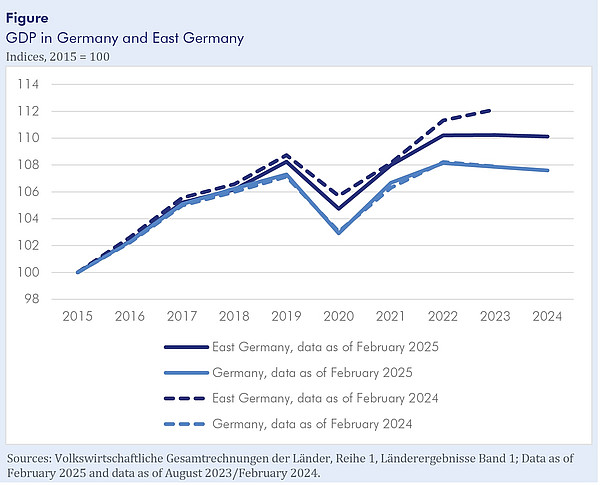In East Germany, as in the west, the economy is in crisis - Implications of the Joint Economic Forecast Spring 2025 and new data for the East German economy

In its Spring Report, the Joint Economic Forecast Project Group states that the German economy has been in crisis since the end of 2023 and that the new US tariffs and the high level of political uncertainty will have a negative impact on activity in 2025. This also applies to East Germany, even if here exports to the US play a smaller role than for the West German economy. In 2024, gross domestic product (GDP) in East Germany fell by 0.1%, which was a bit less than in West Germany (‒0.3%). Production in Berlin increased by 0.8%, while it fell by 0.5% in the other East German states. With the publication of production figures in March 2025, East Germany's GDP has been revised downwards for the past few years (see figure). According to the calculations from spring 2024, it was 12.1% higher in 2023 than in 2015; according to the current calculations, it was only 10.2% higher. The revision of cumulative growth was particularly strong for Brandenburg (4.5% instead of 11.6%), Mecklenburg-Western Pomerania (7.3% instead of 13.3%) and Saxony-Anhalt (‒0.1% instead of 3.3%). If the East German economy grew slightly faster than the German economy as a whole over the past ten years, it was only because services expanded strongly in Berlin.
“In the coming years, a decline in the workforce will place an increasing burden on the East German economy,” says Oliver Holtemöller, Head of the Department Macroeconomics and Vice President at the IWH. Already last year, the number of employees subject to social insurance contributions fell by 0.1% in the east, while it increased by 0.4% in the west. In addition, the majority of armaments investments are likely to be made in West Germany, as this is where the German defense industry is concentrated. Overall, production in East Germany is likely to stagnate in 2025 (Germany +0.1%). Expansion in the following year is forecast to be 1.1%, which is 0.2 percentage points lower than in Germany as a whole. At 7.8% in both 2025 and 2026, the unemployment rate will be slightly higher than in 2024 (7.5%).
Joint Economic Forecast, Spring 2025 Report (in German):
Joint Economic Forecast: Geopolitischer Umbruch verschärft Krise – Strukturreformen noch dringlicher. Essen, April 2025.
Whom to contact
For Researchers

Vice President Department Head
If you have any further questions please contact me.
+49 345 7753-800 Request per E-MailFor Journalists

Head of Public Relations
If you have any further questions please contact me.
+49 345 7753-765 Request per E-MailIWH list of experts
The IWH list of experts provides an overview of IWH research topics and the researchers and scientists in these areas. The relevant experts for the topics listed there can be reached for questions as usual through the IWH Press Office.
Related Publications

Geopolitischer Umbruch verschärft Krise – Strukturreformen noch dringlicher
in: Dienstleistungsauftrag des Bundesministeriums für Wirtschaft und Klimaschutz, 1, 2025
Abstract
<p>Die deutsche Wirtschaft befindet sich weiterhin in der Krise. Der Beginn des Jahres 2025 ist geprägt von erheblichen innen- aber auch außenpolitischen Veränderungen. In Deutschland ist die wirtschaftspolitische Unsicherheit angesichts des Regierungswechsels hoch. Gleichzeitig belastet die protektionistische Handelspolitik der USA die deutsche Konjunktur. Zudem hat sich mit der neuen Regierung in den USA die Sicherheitslage in Europa verschlechtert. Vor diesem Hintergrund haben Bundestag und Bundesrat die Finanzverfassung Deutschlands grundlegend geändert und weitreichende öffentliche Verschuldungsspielräume geschaffen. </p> <p>Die wirtschaftliche Schwäche in Deutschland ist nicht nur konjunktureller, sondern auch struktureller Natur. So sehen sich deutsche Unternehmen einem verstärkten internationalen Wettbewerb vor allem aus China ausgesetzt. Zudem scheint ein Teil der Produktion in der energieintensiven Industrie dauerhaft weggefallen zu sein. Eine schwindende Erwerbsbevölkerung und hoher bürokratischer Aufwand sind weitere strukturelle Schwächen, unter denen die deutsche Wirtschaft leidet. </p> <p>Das Bruttoinlandsprodukt dürfte in diesem Jahr mit einem Anstieg um 0,1 % kaum mehr als stagnieren. Damit revidieren die Institute die Prognose vom Herbst 2024 recht deutlich um 0,7 Prozentpunkte nach unten. Insbesondere im Sommerhalbjahr 2025 wird inzwischen die Dynamik aufgrund der US-Zollpolitik schwächer eingeschätzt. Damit verzögert sich die erwartete Erholung. Im weiteren Prognosezeitraum dürfte eine voraussichtlich expansive Finanzpolitik die Konjunktur beleben. Im kommenden Jahr dürfte steigt das Bruttoinlandsprodukt um 1,3 %, wobei 0,3 Prozentpunkte der höheren Zahl an Arbeitstagen zu verdanken sind. Damit ist die Rate gegenüber der Herbstprognose unverändert, das Niveau der Wirtschaftsleistung ist aber 0,8 % niedriger.</p>



